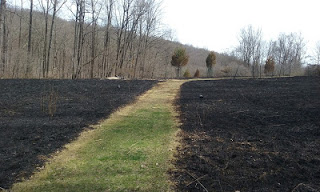I have always thought the period from late August through October to be the saddest time of the year. If you are not already back in school, you will be. The sun sets long before 8 p.m. Leaves are beginning to turn color and/or fall, as is the case with
my old apple tree. The regular baseball season ends in early October.
 |
| Cardinal pair (Margo D. Beller) |
Many birds are migrating south. I haven't seen a hummingbird at the feeder in quite some time. My mother, who was born in late August, died in mid-October. A dear friend, who was born in mid-October, recently died after a long battle against cancer one day after my mother's birthday.
The somber Jewish holidays of Rosh Hashana and Yom Kippur usually fall in September or October. The anniversary of the worst attack in U.S. history occurred on Sept. 11.
By the time November rolls around you are used to the long, cold, dark nights and can look ahead to Thanksgiving and the winter holidays. But now you realize that the cold nights are going to severely hurt or kill your plants and you start to wonder whether to protect them or let them go.
At the same time, there is life.
 |
| Cardinal (Margo D. Beller) |
Some plants bloom at this time of year. In my yard are flowering Rose of Sharon and liriope, with the sedum "Autumn Joy" not far behind. Mums dot suburban doorways.
There are still birds in the yard. A
catbird calls, white-breasted nuthatch and chickadees come to the thistle sock and the cardinals are calling to each other. And there are young cardinals, too, a late brood for these parents.
Cardinals are among my favorite birds. Their size and coloring makes them easy to pick out in bushes and trees. They come to feeders and sit a while to eat, allowing you to admire and photograph them. In spring the red male feeds his mate as part of the pair bonding. It looks like they are kissing. Unlike a lot of other birds, they mate for life. Audubon painted the pair. The adults call to each other constantly, and the male will sit atop a tree and sing lustily during the breeding season, announcing that THIS is HIS territory.
 |
Audubon's portrait of cardinals
(Margo D. Beller) |
Cowbirds will drop eggs into cardinal nests. The young cowbird is usually bigger than the cardinal chicks and either grabs all the food or pushes them from the nest. The adults will feed it anyway out of instinct. I have seen a cowbird chick harassing an adult male cardinal, begging for food, following it wherever it goes until the chick grows big enough to leave and rejoin the cowbird flocks.
And yet,
the cardinal is far from endangered. Today I watch young cardinals follow their parents around the shrubs in my backyard. They are nearly fully grown. When young, cardinals are smaller and brown like their mothers, lacking the red crest and bill. That is for their protection. As they get older, the brown females get their red bills and crests, the males start to grow the more familiar red feathers.
Relatively soon after they can fend for themselves, the young cardinals will find mates.
When winter comes I might have as many as four cardinal pairs visiting the feeder. It will keep them alive this winter until they can breed and keep the cycle going.

















